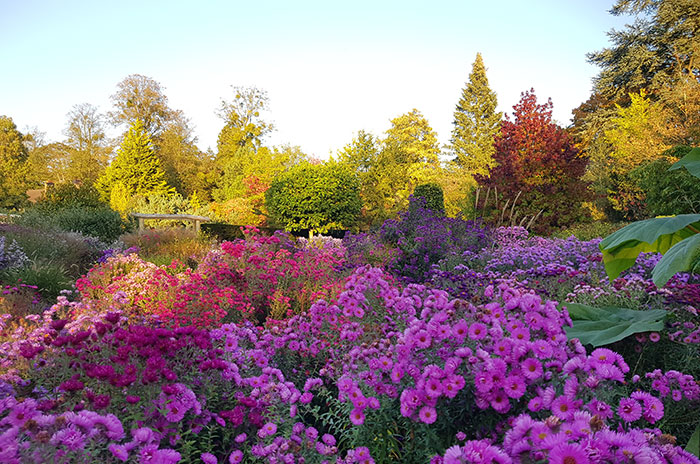Asters
Asters or Michaelmas daisies as they are known as in the UK, are a wonderful diverse group of autumn flowering plants in the daisy (Asteraceae) family. They can range in height from 10 cm (4”) to 200 cm (7’) and come in colours from white, through pink, all the shades of purple into purple-reds and deep purple blues. The flowers are all daisy shaped but range from open starry flowers to formal doubles and in size from tiny daisies held in dense sprays through to huge 7.5cm across single flowers. Originally all members of the genus Aster they are now classified in several different genera. The main groups which are grown in the UK can be found below.
New York Asters – Symphyotrichum novi-belgii (syn. Aster novi-belgii)
Native to North America this is a diverse group which readily hybridises with other species. At the peak of their popularity there were more than one thousand cultivars now a days this is closer to three hundred. Plants vary a great deal in height, 25-180 cm, flower shape, size and colour, as well as disease susceptibility. Typically, the foliage is smooth but ranging in colour from mid-green to purple tinted and individual leaves are usually longer than wide with a pointed tip. Flowers are held in sprays although the shape of these can vary greatly.



Propagation: These plants thrive on regular division which can be done every Spring if desired.
Position: Open sunny site for the majority. Good garden soil which doesn’t get too dry in summer.
Extra tips: Cut back after flowering. Divide every 1-3 years. This group can be susceptible to powdery mildew so ensure good air movement, summer moisture and keep divided regularly. Plants 90 cm tall or more may need staking.
New England Asters – Sympyotrichum novae-angliae (syn. Aster novae-angliae)
Native to the Northern USA and Canada this group forms stout woody clumps with strong woody stems that rarely need staking once established. Apart from S. novae-angliae ‘Purple Dome’ which stands at 45 cm most range from 90cm-200cm. The flowers are all single but usually with a good number of ray florets (petals). The foliage is distinctly rough and pale green. Flowers are held largely at the tops of the plants making them ideal for mid to back of border positions.


Propagation: Easiest done through division which can be carried out in Autumn or Spring. Every 3 to 5 years is usually ideal.
Position: Open sunny site in any good garden soil. The freer draining the soil the shorter the plant will be. This group rarely suffers from powdery mildew and exhibit good drought tolerance.
Small Flowered Asters
This group is made up of several different North American species and hybrids which are mainly in the genus Symphyotrichum. Many cultivars are older, and all have good levels of disease resistance. All produce small daisies on mass in fluffy sprays, mostly flowering in October. Many are also very good as cut flowers. The main species are:
Symphyotrichum cordifolium (Blue Wood Aster) – this includes plants such as ‘Chieftain’ and hybrids like ‘Little Carlow’. They have distinctive heart-shaped (cordate) lower leaves and large sprays of flowers. Tolerant of light shade they have good levels of resistance to powdery mildew. The clumps are tight and the heights range from 90cm to 180cm.
Symphyotrichum ericoides (Heath Aster) - Includes plants such as the prostrate ‘Snow Flurry’, the bushy ‘Golden Spray’ and hybrids such as ‘Ochtendgloren’. The foliage is dainty, and the habit is bushy from tight clumps. Heights range from 10 cm to 100 cm. They prefer good light and have good disease resistance. Ideally, they prefer reasonable winter drainage.
Symphyotrichum lateriflorum (Calico Aster) – Masses of distinctive small white flowers with prominent discs that are often purple-pink in colour. October flowering, disease and drought resistant. Tolerant of light shade. The species forms slowly spreading clumps forms such as S. lateriflorum var. horizontale have form tight clumps with very bushy growth. Height range 60 – 90 cm.

Propagation: For all sections easiest from Spring division every 3 to 5 years.
Extra Tips: Keep a look out for the other species and hybrids in this groups such as S. turbinellum, the prairie aster.
Other Species Asters
The genus Eurybia is included here which has several shade tolerant tough plants such as E. divaricata and E. x hervyi. Also included here is the genus Doellingeria and cultivars of Symphyotrichum laeve such as ‘Calliope’ as well as the Asiatic Asters such as Aster trifoliatus.
European Asters
This section includes Aster amellus, Aster pyrenaeus and Aster x frikartii. All are mildew resistant and flower from late July to October. They all have large single flowers and rough hairy foliage. The clumps are tight, and they prefer neutral to alkaline soils with good winter drainage. It is best to divide these plants every 5 years. Propagation can be done through division or tip cuttings in the Spring.

We propagate all our plants from stock in the garden so the range available does vary from year to year. If you are looking for something specific it is best to order either for delivery or you can collect the plants from the nursery or an event we are attending. We recommend orders should be made before March to avoid disappointment as many varieties are propagated to order in February. Mail order is sent out in May. Click here to order online.
When visiting the nursery, you will always find a good range of asters available to buy and if you can’t find what you are looking for it is always worth asking.
To find more information about Asters the following two books are still readily available.
The Gardener’s Guide to Growing Asters by Paul Picton published by David & Charles (ISBN 0-7153-1885-3) 1999
The Plant Lovers Guide to Asters by Helen Picton & Paul Picton published by Timber Press (ISBN 978-1-60469-518-2) 2015

